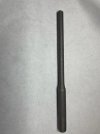It is a nice solution to have
Having a way to save brass that is still in good shape.
We messed around with the punch and ball bearing years back on some 6.5x47 and 338LM brass that got stressed out some due to running some higher pressure loads or using powder that was more temp sensitive. But it seemed all a person was doing was distorting the leading edge of the pocket some in which created some pinch in the primer pocket enough to hold the primer better.
Some folks will run a lower pressured load a couple times and feel that the primer pockets tightens up some, I never tried this but know of folks that do it with their 6.5x47s today yet.
I do have smith/machine shop that uses collets and a dead blow press system to refurbish my large brass when the pockets got a little loose on some test rounds or just running it hot at a event when the temps creep into the 100 degree mark. The brass is very expensive to start with and they do bring the case head portion of the brass back to the specs when it was new without distorting it. This process also does not effect the accuracy or performance of the load, if it did we would be culling this brass for close up targets. The ES - SD numbers are single digit and down range impacts water line well. We also try to not get crazy on speed, the goal is to float around 3065 fps with the 550s even though 3200+ can be had. It just saves brass not pushing it as well as keeping it under 3200 seems to help with throat erosion.
Here again I will say when it come to brass
if sized correctly you control case head separation
if annealed you save the necks from cracking and maintain neck tension
The primer pockets are the next weak link and I'm glad we have a better way of correcting them when needed.
Here is the large brass I spoke of - a 416 Warner with the 550 Flat Line next to a 260
I'm sure glad that the brass can be refurbished- fixed correctly versus having to through very good expensive brass away.
Osoh

